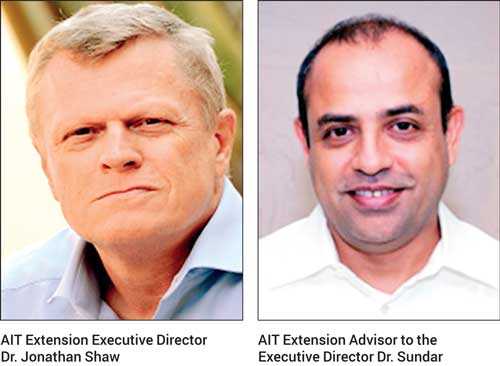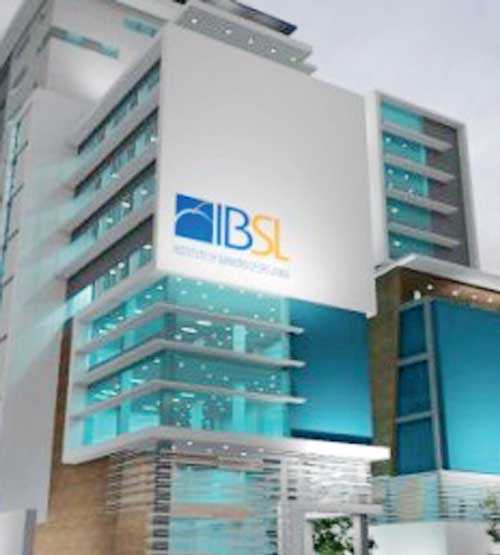Monday Mar 03, 2025
Monday Mar 03, 2025
Monday, 28 October 2019 00:00 - - {{hitsCtrl.values.hits}}

Asian Institute of Technology
The humble beginning as Bankers’ Training Institute
Institute of Bankers of Sri Lanka or IBSL, during its 55 years of service as the single most important professional body providing qualifications to bankers in Sri Lanka, has produced more than 20,000 certificate and diploma holders, associates and fellows. Go to any bank in the country and you will find an associate or a fellow of IBSL working there. There have been a number of milestones in its history after it was started in 1964 as the Bankers’ Training Institute or BTI by the active leadership of the Central Bank and participation by the country’s banking institutions.
From BTI to IBSL
In 1979, BTI was incorporated as the Institute of Bankers of Sri Lanka by an Act of Parliament. In 2000, it got itself affiliated to the Chartered Institute of Bankers or CIB, London which is presently known as the Institute of Financial Services or IFS. Under this arrangement, the qualifications offered by IBSL were accredited by ISF giving IBSL a global recognition. Though this was discontinued in 2010 after IFS became a degree awarding institution in the UK, IBSL on its own grew both vertically and horizontally. 
Its vertical growth encompassed consolidation of the quality standards of the qualifications it offered to bankers. The horizontal growth took the form of expanding the curricula into financial services including insurance. Now, it is planning to set another milestone by teaming with the Thailand based Asian Institute of Technology, commonly known as AIT, to offer its Professional Master’s Degree in Banking and Finance, abbreviated as PMBF, in Sri Lanka.
Since IBSL is planning to become a degree awarding institution in the country in the near future, its academic collaboration with AIT will help it to gain valuable experience in offering academic courses and running a higher learning institution.
AIT: The regional technological university
AIT was established in 1959 as a regional university on the model of USA’s Massachusetts Institute of Technology or MIT to produce scientists and engineers needed for rapid development of the region. Initially, it offered only courses in science and technology, but later ventured into management by establishing a business school known as the School of Management or SOM. Under SOM, AIT has an extension branch, known as AIT Extension, which provides high level training to participants from the region in almost every major area of its speciality.
There are thousands of alumni of AIT Extension, globally dispersed and working in governments, businesses and universities. The latest addition to AIT Extension was its postgraduate degree course at the Master’s Degree level titled Professional Master’s in Banking and Finance or PMBF. Since it was launched in 2011, there had been more than 100 graduates who had completed it from Bangladesh, Myanmar, Cambodia and Sri Lanka.
AIT Extension: The training arm of AIT
Dr. Jonathan Shaw, Executive Director in charge of AIT Extension, says that his outfit contributes to the development of the region through continuing professional education, short-course training and consultancy services. “AIT Extension works across a broad range of sectors and disciplines. If it is a tree, it is grown on solid ground made up of faculty members, professionals with sectoral experience and a team of expert learning specialists. The tree has now grown into branches covering such fields and disciplines like management, environment, planning, technology, agriculture, education, development, engineering, banking and finance, governance and healthcare services. Through our short-term education and training courses, we offer facilities for study visits by participants to enable them to meet their continuing professional development needs,” says Shaw.
IBSL is a professional body that has been providing professional qualifications to bankers in Sri Lanka for more than five decades. Its charter has been awarded by Parliament through an Act. It has an excellent governance structure guided and led by the country’s Central Bank. While the Governing Board consists of representatives from all the banks, its Chairmanship is held by a Deputy Governor and vice-chairmanship by an Assistant Governor of the Central Bank. Besides, it has a state-of-the-art new premises from which PMBF can be delivered to prospective candidates easily. Therefore, AIT very willingly chose IBSL as its local affiliated institution –
Dr. Sundar Venkatesh
How does it offer its services to participating professionals? I asked Shaw. “We work with professionals in national governments, overseas development agencies, multilateral agencies, development institutions, private sector businesses, investment banks and NGOs,” he elaborated. “The needs of these groups are diverse. Hence, our entry requirements are flexible. Normally, participants in training programs are mid-career and senior level professionals with a minimum of two years of experience. We conduct our courses in English but in exceptional cases in the native language of the participants.” 
Professional Master’s in Banking and Finance
PMBF was specifically designed by AIT Extension as a blended program – blending professional content with academic learning – to cater to midlevel bankers in need of continuing professional development. The demand for such a blended postgraduate degree normally comes from central banks and commercial banks. Accordingly, central bankers from Bangladesh and Myanmar and commercial bankers from Sri Lanka, Bhutan and Cambodia were the bankers who have received this blended training from AIT.
Subsequently, development bankers from the region too have completed the degree. Dr. Sundar Venkatesh, Advisor to the Executive Director of AIT Extension, had been the brainpower behind PMBF at AIT. I asked Venkatesh why AIT Extension chose to introduce this degree.
Need for updating the knowledge of bankers
“AIT Extension had been training bankers from the region for more than two decades,” Venkatesh began his explanation. “Those training programs helped bankers to keep themselves up to date, specifically in new trends like branchless banking, application of artificial intelligence, the use of machine learning and above all, new financial sector platforms like the blockchain. But, we found that they needed more guided training in risk management in banks, how banking supervisors have been changing the rules of the game and report writing. Those goals cannot be met through short-term training courses. To build a banker professionally, it was necessary to coach them closely for a longer period than the usual two to three weeks that we spent for short term training, especially when it came to report writing and undertaking special projects. But the problem was that they could not spend long periods like two years away from their work desks. So, we limited it to one year within which they are taken through the essentials which a professional banker should know.”
Banking risks coming from market and global developments
Venkatesh is of the opinion that modern day bankers should know from where the risks come to a bank. He elaborated on this point. “Traditionally, banking risks emanated from within banks like frauds or mismanagement. Still, they are vital sources of risk if they occur sufficiently on a large scale to threaten a bank’s smooth functioning. But the consolation was that they were within the control of a bank and therefore adequate measures could be taken to keep them under check if total elimination is not possible. However, modern day risks basically come from outside the banks, from the market and from global developments. They are not within the control of a bank. When they occur and hit the banking industry, banks become helpless unless they are fully prepared for them. Therefore, banking training programs should prepare bankers to meet this challenge appropriately.”
Unlicensed financial service providers
One such area which was not foreseen by either banking regulators or banks themselves was the ‘blurring’ of the difference between banks and other business ventures. Previously, a bank which provided financial services to its customers could be identified uniquely. If you have got a licence from the regulator to operate a bank, you were a bank and there was no any dispute about it. But, today, financial services are not limited only to those institutions that have got a licence from the regulator to run a bank. That unique position enjoyed by banks for long has now been challenged by market developments. I asked Venkatesh how this aspect has been incorporated into the curriculum of PMBF.
Competition from technological giants
“The biggest competitor to a bank today is not other banks in the sector. They still compete with each other to grab a share of the market for themselves. This is what management Gurus tell us as operating in the red ocean. But the real problem is something else. There is a blue ocean in the banking sector which is limitless and needs be charted afresh. Bankers should pioneer to chart this market and develop it. But the technology companies have ventured into this blue ocean and are competitively displacing banks from the scene. Therefore, bankers should first diagnose the problem and then quip themselves with the necessary technical knowhow to compete with technological giants. We have incorporated this to our curriculum so that those who complete PMBF are adequately prepared to face the challenge,” he said.
Three goals of PMBF
Accordingly, PMBF seeks to attain three goals. One is to ‘empower professional bankers with knowledge and skills to meet current and emerging challenges with the fast-changing business environment in the industry’. The second is to improve the knowledge base of the participants to ‘perform their role effectively as bankers’. The third will attempt to do this by combining theory with practice through ‘a balanced exposure to the theory, case studies and practical skills that will enhance both the personal and professional development of the participants’. “It is our objective,” elaborated Venkatesh, “to develop a holistic banker who has exposure to both the theory and practice. That is why we call it Professional Master’s instead of just Master’s.” 
A faculty with practical experience
What facilities has AIT Extension got to deliver what it promises to do? I asked Venkatesh. “A number of facilities,” he said. “Our faculty is a combination of academics and practising bankers drawn from the region. In order to cross-fertilise knowledge and allow participants to learn from each other, we have selected participants from a number of countries and diverse institutions. They are encouraged to share experiences with each other and critically look at the mistakes made by some countries, while identifying plus points for emulation. They have to use the knowledge they gain during the course to identify and provide solutions for a practical problem they have in their own banks as the final research project which is guided by both academics and practical bankers. In the past, those research projects which our students have completed have been highly appreciated by their employers.”
Sri Lanka is getting ready to face disruptive technologies in banking
Up to this year, PMBF was conducted on campus at AIT in Thailand. Students from different countries, including Sri Lanka, had to travel to Thailand and take residence for one year at AIT to complete the degree. But from this year onward, AIT is planning to conduct a parallel PMBF in Colombo, Sri Lanka. What was the reason for selecting Sri Lanka? I asked Venkatesh. “Sri Lanka’s banking sector is expanding at a rate today,” said Venkatesh.
“It needs more qualified bankers to run banks in a changing environment, basically driven by disruptive technological advancements as the Association of Professional Bankers had themed in this year’s annual sessions. I was a participant in these sessions and found that bankers were all clamouring to make Sri Lanka’s banking sector the top one in South Asia. In this background, AIT’s entry to Sri Lanka’s educational sector is well timed. Besides, Sri Lanka is going to become an educational hub for the South Asian region taking advantage of its low living costs and unique strategic location. By coming to Sri Lanka, we can attract students from both India and Pakistan which are two rival countries but find Sri Lanka a common neutral ground.”
IBSL, an institute with a good governance structure
AIT has chosen IBSL as its affiliated institution to deliver PMBF in Sri Lanka. Why IBSL? Why not a university or any other professional body? Venkatesh clarified the reasons for selecting IBSL. “IBSL is a professional body that has been providing professional qualifications to bankers in Sri Lanka for more than five decades. Its charter has been awarded by Parliament through an Act. It has an excellent governance structure guided and led by the country’s Central Bank. While the Governing Board consists of representatives from all the banks, its Chairmanship is held by a Deputy Governor and vice-chairmanship by an Assistant Governor of the Central Bank. Besides, it has a state-of-the-art new premises from which PMBF can be delivered to prospective candidates easily. Therefore, AIT very willingly chose IBSL as its local affiliated institution.”
PMBF is to be launched in Sri Lanka in early November at a ceremony attended by the Governor of the Central Bank, Dr. Indrajit Coomaraswamy, as the Chief Guest and the President of AIT, Dr. Eden Y. Woon, as the Guest of Honour. The course will begin, according to Venkatesh, in early 2020.
(The writer, a former Deputy Governor of the Central Bank of Sri Lanka, can be reached at [email protected].)
Discover Kapruka, the leading online shopping platform in Sri Lanka, where you can conveniently send Gifts and Flowers to your loved ones for any event including Valentine ’s Day. Explore a wide range of popular Shopping Categories on Kapruka, including Toys, Groceries, Electronics, Birthday Cakes, Fruits, Chocolates, Flower Bouquets, Clothing, Watches, Lingerie, Gift Sets and Jewellery. Also if you’re interested in selling with Kapruka, Partner Central by Kapruka is the best solution to start with. Moreover, through Kapruka Global Shop, you can also enjoy the convenience of purchasing products from renowned platforms like Amazon and eBay and have them delivered to Sri Lanka.
Discover Kapruka, the leading online shopping platform in Sri Lanka, where you can conveniently send Gifts and Flowers to your loved ones for any event including Valentine ’s Day. Explore a wide range of popular Shopping Categories on Kapruka, including Toys, Groceries, Electronics, Birthday Cakes, Fruits, Chocolates, Flower Bouquets, Clothing, Watches, Lingerie, Gift Sets and Jewellery. Also if you’re interested in selling with Kapruka, Partner Central by Kapruka is the best solution to start with. Moreover, through Kapruka Global Shop, you can also enjoy the convenience of purchasing products from renowned platforms like Amazon and eBay and have them delivered to Sri Lanka.